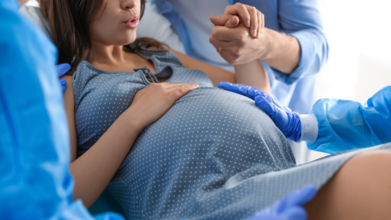- Health Conditions A-Z
- Health & Wellness
- Nutrition
- Fitness
- Health News
- Ayurveda
- Videos
- Medicine A-Z
- Parenting
- Web Stories
'Water Breaking', What Does It Really Mean?

Credits : Canva
If you know anything about pregnancy, you would know about "water breaking". Even if you do not know enough, this is one thing which you may know through popular media or depiction of a pregnant woman going to labor in series. It is when their "water breaks". Have you ever thought where that "water" came from? Well, we got you the answers, it’s amniotic fluid. This fluid plays a critical role during pregnancy, providing the baby with the ideal environment to grow and develop. However, complications can arise when there’s too much or too little of it, requiring close monitoring to ensure a safe delivery.
Let’s explore what amniotic fluid is, why it’s important, and what happens when levels are outside the normal range.
What is Amniotic Fluid or the "water" that breaks?
"Water" or the amniotic fluid is a clear or slightly yellow liquid that surrounds the baby inside the amniotic sac. It begins forming soon after conception and serves multiple purposes:
- This fluid helps with protection of the baby as it cushions the baby and prevents injury.
- It also supplies essential nutrients, proteins, and electrolytes.
- The fluid allows the baby to practice swallowing and breathing, aiding in the development of the lungs, digestive system, and muscles.
- The fluid contains antibacterial properties that help protect against infections.
- Amniotic fluid levels typically peak between 29 and 37 weeks of pregnancy and gradually decrease closer to delivery.
Are there any levels that ensures that the fluid is not more than it's needed:
Doctors measure amniotic fluid using an amniotic fluid index (AFI) during ultrasounds. Normal levels range between 5 cm and 25 cm. Variations outside this range are categorized into two main conditions:
- Oligohydramnios: When There’s Too Little Fluid
- Oligohydramnios refers to low levels of amniotic fluid (less than 5 cm). This condition can develop at any stage of pregnancy and may be diagnosed during routine ultrasounds or if your belly measures smaller than expected for your gestational age.
Symptoms:
- Decreased fetal movement
- Fluid leakage from the vagina
- Abdominal pain
Causes:
- Placental issues
- Maternal dehydration or diabetes
- Multiple pregnancies
- Premature rupture of membranes
Treatment:
Oligohydramnios is managed through close monitoring, increased hydration, and, in some cases, early delivery (typically after 37 weeks). Severe cases may require additional interventions to ensure the baby’s safety.
Anhydramnios: The Severe Form of Oligohydramnios
Anhydramnios occurs when there is no measurable amniotic fluid. This rare but serious condition often leads to severe complications, including underdeveloped lungs and skeletal abnormalities.
Prognosis:
Anhydramnios is most dangerous when diagnosed early in pregnancy. Babies with this condition often face significant challenges, including a high risk of stillbirth.
Polyhydramnios: When There’s Too Much Fluid
On the other end of the spectrum, polyhydramnios occurs when amniotic fluid levels exceed 25 cm.
Symptoms:
- Difficulty breathing
- Swelling in the legs and feet
- Heartburn
Causes:
- Gestational diabetes
- Infections
- Genetic disorders
Treatment:
Mild cases are typically monitored, while severe cases may require draining excess fluid or treating underlying conditions. Without proper management, polyhydramnios can lead to complications such as premature labor, placental abruption, or umbilical cord issues.
What Happens if You Leak Amniotic Fluid?
Leaking amniotic fluid before labor, known as premature rupture of membranes (PROM), can be a medical emergency.
Types of PROM:
Term PROM: Occurs after 37 weeks.
Preterm PROM (PPROM): Occurs before 37 weeks
Risks of PROM:
- Infection
- Premature labor
- Cord prolapse
Treatment depends on how far along you are in your pregnancy. It may include bed rest, antibiotics, or inducing labor.
What’s the Outlook for Amniotic Fluid Conditions?
The outcome for these conditions depends on when they occur and how they are managed:
- Oligohydramnios: Better outcomes are expected in the third trimester. Early occurrences carry higher risks.
- Anhydramnios: This condition poses severe risks, especially before 24 weeks.
- Polyhydramnios: Rarely causes complications unless severe, but it can lead to preterm labor.
- PROM: Most pregnant individuals go into labor within 24 hours of PROM at term, but preterm PROM carries higher risks.
A Viral Instagram Post Makes Several Claims On What Makes Your Kids Sick After A Swimming Session, We Fact Checked It For You, Here's What We Found

Credits: Canva
As summers are here and so are the pool sessions, an Instagram post is making rounds on the social media platform by Ilia Ototiuk, who calls himself an ambassador of discipline, mental and physical wellbeing. The post lists down the reason why kids get sick after a swimming session. The post mentions that the reason is not water, but something else. Health And Me decided to fact check each claim made on the post, and here is what we found.
Claim #1: “The problem isn’t cold water or swallowing pool water.”
Fact Check
According to the US Centers for Disease Control and Prevention (CDC), swallowing or inhaling contaminated pool water can absolutely cause illness. particularly gastrointestinal infections like diarrhea. Germs such as Cryptosporidium can survive for over a week in properly treated pools. While temperature itself doesn’t directly cause colds, swallowing pool water can spread pathogens.
Verdict: Cold water alone won’t give a child a cold, but contaminated water can cause infections.
Claim #2: “The real immune crash happens right after getting out. The body is warm, skin is wet...”
Fact Check
The claim that wet skin and drafts cause an “immune system shutdown” isn’t supported by medical evidence. What actually happens is explained by US Masters Swimming: sudden exposure to cold water can trigger cold water shock, affecting heart rate, breathing, and circulation. Extended exposure can lead to hypothermia or afterdrop (continued cooling even after leaving the water).
Verdict: The body does not “shut down immunity.” Instead, risks are linked to cold-water shock and hypothermia, especially if kids don’t warm up quickly after swimming.
Claim #3: “Sitting around in wet swimsuits for 5–10 minutes makes the body vulnerable.”
Fact Check
As per Texas A&M Health and the Mayo Clinic, sitting in wet swimsuits doesn’t cause colds, but it can cause fungal infections (like yeast infections or jock itch) and skin irritation from chafing. Prolonged dampness makes an ideal environment for fungi and bacteria.
Verdict: The real risk is fungal or bacterial skin infections, not colds. Parents should change kids into dry clothes quickly after swimming.
Claim #4: “Not drying hair causes sinus overload and colds.”
Fact Check
The Cleveland Clinic explains that wet hair itself does not cause colds. Viruses such as rhinovirus are the culprits, not damp scalps. While cold environments may help viruses spread more easily, wet hair is not a direct cause of runny noses, sore throats, or fevers.
Verdict: Leaving hair wet or letting it "air dry" won’t cause colds. However, drying kids’ hair after swimming can help them stay comfortable and prevent feeling chilled.
Claim #5: “Skipping post-swim snacks weakens immunity.”
Fact Check
According to the BBC 2023 report, post-exercise nutrition is important, especially within 30–60 minutes after swimming. The body needs carbohydrates to replenish glycogen and protein to repair muscles. Skipping food doesn’t directly cause infections, but poor recovery can increase fatigue and stress, making the body less resilient.
Verdict: It’s true that kids should eat a balanced snack after swimming, ideally carbs + protein, but saying “immunity weakens” without food is an exaggeration.
Fact Check: Is Giving Birth On Your Back Against Your Body's Natural Anatomy?

Credits: Canva
"I may or may not burst some bubbles with this comment, but what if I told you that your pelvis was in fact not too small and or that your baby's head was in fact not too big?" says Amber Grimmett, a US-based Pregnancy and
Postpartum Coach. In her post, she also writes that the position most women give birth in, also called the lithotomy position or lying on your back is "against your body's natural birth mechanics". In a video she posted on her Instagram @fierce.not.fragile, she talks about pelvis and baby's head size, explaining how the birthing position that has been made standard may not be right.
She says that when the mother lies flat on her back with knees wide, her tailbone cannot move freely and the pelvic outlet, the space baby needs to exit, "literally closes off".
This, she says, creates a domino effect. Then comes longer labors, more interventions, and higher risk of pelvic floor dysfunction. "Your body was designed to birth, but not in positions that fight against its natural design," she writes.
What Does Science say?
We did a fact check on her claim and here's what we found.
For most women in the United States today, giving birth means lying on a bed, feet in stirrups, and being told when and how to push. But mounting research, including a 2014 study published in The Journal of Perinatal Education, titled, 'Healthy Birth Practice #5: Avoid Giving Birth on Your Back and Follow Your Body’s Urge to Push' suggests this common practice, known as the supine or lithotomy position—might not actually be the safest or most effective way to bring a baby into the world.
How Birth Ended Up on Its Back
For centuries, women birthed in positions that worked with gravity, standing, squatting, sitting, or even using stools or ropes for leverage. These upright positions made physiological sense: gravity helped the baby descend, shortened labor, and reduced maternal fatigue.
Then came King Louis XIV of France. Fascinated by childbirth, he reportedly preferred to watch his mistresses deliver, and lying flat gave him the best view. The practice caught on among European aristocracy and eventually spread widely.
By the early 1900s, births had largely moved from homes to hospitals. Doctors saw childbirth less as a natural process and more as a medical procedure. Putting women on their backs gave physicians easier access for interventions such as forceps delivery, anesthesia, and continuous fetal monitoring. Convenience for the doctor—not necessarily benefit for the mother or baby, became the standard.
The Problem with the Supine Position
Research over the past three decades has consistently shown that giving birth lying flat has no clear benefits for either mother or baby. In fact, there are multiple disadvantages:
- Longer Labor: When women lie flat, the baby must work against gravity, which can slow descent.
- Narrower Pelvis: The supine position can actually reduce pelvic diameter, making delivery more difficult.
- Increased Risk of Interventions: Supine births are linked with more use of forceps, vacuum deliveries, and episiotomies.
- Reduced Blood Flow: Lying on the back can compress major blood vessels behind the uterus, reducing blood flow to the baby.
- More Perineal Trauma: Directed, forceful pushing while on the back is associated with more tears and a weakened pelvic floor, raising the risk of urinary incontinence later.
Despite this, U.S. survey data shows that nearly 70% of births still happen in supine or lithotomy positions, with fewer than 10% of women using traditional squatting, standing, or side-lying positions.
The Case for Upright and Spontaneous Pushing
Standing, kneeling, and squatting use gravity to help the baby descend and can even widen the pelvic outlet, giving more room for delivery. Even side-lying, which is gravity-neutral, has been shown to reduce perineal tearing.
Equally important is how women push. Many hospitals still direct women to push forcefully for long periods, holding their breath. But evidence shows that spontaneous, self-directed pushing—where the woman follows her own urge, improves oxygenation, reduces maternal stress, and lowers the risk of fetal distress.
In fact, research has found that directed pushing only shortens labor by about 13 minutes on average, a difference not considered clinically significant but one that may come at the cost of pelvic floor damage.
Rethinking Hospital Policies
Some hospitals have strict time limits on how long the second stage of labor (pushing phase) can last before recommending interventions such as a C-section, even if there are no signs of danger for mother or baby. Recent guidelines from the American College of Obstetricians and Gynecologists (ACOG) now acknowledge that the second stage can safely last much longer, up to five hours for first-time mothers with an epidural.
However, there is little emphasis on letting women move freely, change positions, or delay pushing until their natural urge returns. This gap between research and practice persists, though midwives and doulas are often more supportive of these evidence-based approaches.
Your Children Are Not At Fault For Being Lazy, You Are: Study Finds The Effect Of Inactive Parents On Children

(Credit- Canva)
Getting children to be active and socialize is a big part of parenting. Even kids, no matter how energetic they are, like lazing around and relaxing. However, this habit can catch on quick, but they are not entirely at fault for it.
A new study has found a strong connection between what parents do and how active their kids are. It turns out that children are more likely to be "couch potatoes" or full of energy based on what they see their moms and dads doing every day.
In a study published in the journal Sports Medicine and Health Science. Researchers showed that when parents have an active routine, their children are less likely to sit still for long periods. The study followed 182 kids and their parents for a week and found that children of inactive parents were more sedentary, while those with active parents were more active themselves.
Do Mothers Influence Their Kids More Than Fathers?
Interestingly, the study discovered that mothers have more than twice the influence of fathers on their children's physical activity. This finding held true even when the researchers considered other things like the family’s income or the child’s age. The experts believe that active parents not only know how important exercise is but also actively encourage their kids. They might be more likely to limit screen time and support activity by taking their children to the park, buying sports equipment, or setting up games in the backyard.
How Can We Encourage Kids to Be More Active?
While a lack of time or safe places to play can make it hard for kids to be active, this study highlights how important a parent's example is. The results suggest that by promoting active habits within families, we can improve the health of the next generation. The researchers believe these findings can be used to create public campaigns and policies that encourage families to live a more active lifestyle together.
How Can Lack Of Activity in Children Affect Their Health?
According to the American Heart Association, physical activity is vital for everyone, but it’s especially important for helping children grow into healthy adults. They suggests that kids and teens (ages 6–17) should get at least 60 minutes of moderate to vigorous physical activity every day. In a world full of digital distractions, it can be a challenge to get kids moving, but teaching them healthy habits now can set them up for a lifetime of well-being.
Kids are naturally active, but they often become less so as they get older, especially girls. If your child's interests change, that's okay—the key is to help them find a new activity they enjoy.
- Be active yourself and find ways to get the whole family moving together.
- Encourage your kids to choose activities they genuinely like. Don't use physical activity as a form of punishment.
- Reduce the amount of time they spend on devices, watching TV, or playing video games.
- Give them toys and equipment like bikes, skateboards, and balls.
- Encourage them to join sports or other activities like dance or swimming. Explore local parks, pools, and bike paths.
- If your child is currently inactive, begin with small, gradual steps to avoid injury or discouragement.
- Reward and encourage your kids for their efforts to help them stay motivated.
© 2024 Bennett, Coleman & Company Limited

